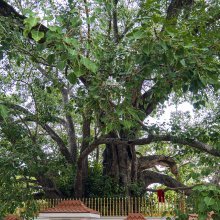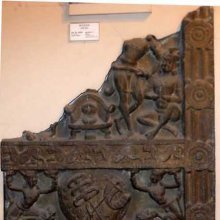Bodhi Tree: 4 definitions
Introduction:
Bodhi Tree means something in Buddhism, Pali, the history of ancient India, biology. If you want to know the exact meaning, history, etymology or English translation of this term then check out the descriptions on this page. Add your comment or reference to a book if you want to contribute to this summary article.
Images (photo gallery)
(+26 more images available)
In Buddhism
General definition (in Buddhism)
Source: Wisdom Library: BuddhismBodhi Tree:—Also called Pipal tree, the kind of tree Shakyamuni sat under attain to attain enlightenment.
Source: WikiPedia: BuddhismThe Bodhi Tree, also known as Bo (from the Sinhalese Bo), was a large and very old Sacred Fig tree (Ficus religiosa) located in Bodh Gaya (about 100 km/62 mi from Patna in the Indian state of Bihar), under which Siddhartha Gautama, the spiritual teacher and founder of Buddhism later known as Gautama Buddha, achieved enlightenment, or Bodhi. In religious iconography, the Bodhi tree is recognizable by its heart shaped leaves, which are usually prominently displayed.
Source: Buddhism Tourism: Glossary of Buddhist TermsThis refers to the tree under which the Buddha attained enlightenment. The original tree was destoryed in the 7th century, however the offshoots of this tree are still there in Sri Lanka and India.
India history and geography
Source: archive.org: Ceylon Branch of the Royal Asiatic Society 1963The Bodhi tree at the Mahāvihāra in Anurādhapura.—The received tradition is that the Bodhi Tree was a sapling of the Tree at Bodh-Gaya in India, that it was brought to Laṅkā, by Saṃghamitta with the consent of the Mauryan Emperor, Asoka, and that it was planted at Anurādhapura, on ground consecrated by the Buddha, by Devānaṃpiya Tissa in B.C. 246 in the presence of Mahinda Thera and a great multitude.

The history of India traces the identification of countries, villages, towns and other regions of India, as well as mythology, zoology, royal dynasties, rulers, tribes, local festivities and traditions and regional languages. Ancient India enjoyed religious freedom and encourages the path of Dharma, a concept common to Buddhism, Hinduism, and Jainism.
Biology (plants and animals)
Source: Google Books: CRC World Dictionary (Regional names)Bodhi tree in English is the name of a plant defined with Ficus religiosa in various botanical sources. This page contains potential references in Ayurveda, modern medicine, and other folk traditions or local practices It has the synonym Urostigma religiosum Gasp. (among others).
Example references for further research on medicinal uses or toxicity (see latin names for full list):
· Ric. Caprifico (1845)
· Species Plantarum
· Not. Pl. Asiat. (1854)
· Plant Systematics and Evolution (1987)
· Bot. Mat. Med. (1812)
· Numer. List (4493)
If you are looking for specific details regarding Bodhi tree, for example pregnancy safety, extract dosage, chemical composition, diet and recipes, side effects, health benefits, have a look at these references.

This sections includes definitions from the five kingdoms of living things: Animals, Plants, Fungi, Protists and Monera. It will include both the official binomial nomenclature (scientific names usually in Latin) as well as regional spellings and variants.
See also (Relevant definitions)
Full-text (+220): Satyavadini, Shreyasi, Dharmamati, Tissarama, Ashvattharaja, Mahametta, Bodhidruma, Samangini, Vidhurinda, Animisa Cetiya, Bodhivrikshadevata, Kotthagama, Shrivriddhi, Ojobala, Jagatidayaka, Venu, Valgu, Ojapati, Pacinatissa Vihara, Ojopati.
Relevant text
Search found 80 books and stories containing Bodhi Tree; (plurals include: Bodhi Trees). You can also click to the full overview containing English textual excerpts. Below are direct links for the most relevant articles:
Mahavamsa (by Wilhelm Geiger)
Chapter 19 - The Coming Of The Bodhi-tree
Chapter 18 - The Receiving Of The Great Bodhi-tree
Apadana commentary (Atthakatha) (by U Lu Pe Win)
Commentary on Biography of the thera Pulinapūjaka < [Chapter 3 - Subhūtivagga (section on Subhūti)]
Commentary on Biography of the thera Gandhodakiya < [Chapter 6 - Bījanivagga (section on Bījani)]
Commentary on Biography of the thera Asananbodhiya < [Chapter 6 - Bījanivagga (section on Bījani)]
Amaravati Art in the Context of Andhra Archaeology (by Sreyashi Ray chowdhuri)
Worship of the Bodhi-tree < [Chapter 3 - Amarāvatī and the Formative Stage of the Buddhist Art]
Bodhisattva’s Enlightenment < [Chapter 3 - Amarāvatī and the Formative Stage of the Buddhist Art]
Vajrāsana and Siṃhāsana < [Chapter 3 - Amarāvatī and the Formative Stage of the Buddhist Art]
The Indian Buddhist Iconography (by Benoytosh Bhattachacharyya)
Figure 2 - Symbol Worship (1): Bodhi Tree (Amaravati)
Figure 45 - Seven Mortal Buddhas with Maitreya
Maha Prajnaparamita Sastra (by Gelongma Karma Migme Chödrön)
III. The procession to bodhi < [Part 10 - Looking in the manner of the elephant, etc.]
Appendix 2 - The deity of the Bodhi tree (bodhivṛkṣadevatā) < [Chapter VI - The Great Bhikṣu Saṃgha]
Part 10 - Looking in the manner of the elephant, etc. < [Chapter LI - Seeing all the Buddha Fields]
The Mahavastu (great story) (by J. J. Jones)
Chapter XXIV - After the enlightenment < [Volume III]
Chapter XXX - The second Avalokita-sūtra < [Volume II]
Chapter XXII - The temptation by Māra < [Volume II]





